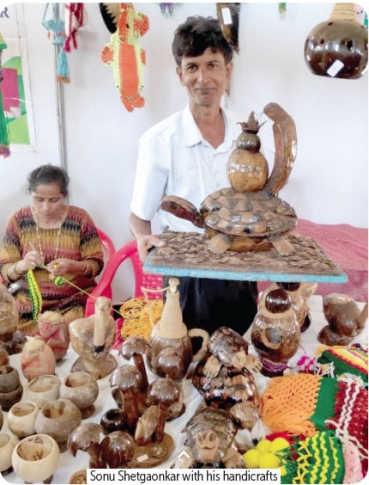
Aalokshi Awade
In Sanskrit, the coconut is known as ‘Kalpavriksha’, translating it as ‘Divine Tree’. The term coconut dates back to the 16th century. The coconut tree has multiple uses. The tender coconut serves as a refreshing drink that can be directly sipped from the unripe coconut; the inner portion of the tender coconut is equally nutritious and is rich in multiple vitamins and minerals. When ripened, it is utilized in various curries or even for desserts. Dried and shredded or desiccated coconut is used to thicken curries and the oil derived from coconut is commonly used for frying and has miraculous benefits for hair, and skin and is prominently used in home remedies due to its healing and medicinal benefits. Jaggery or Palm sugar is prepared from the sap and it is further fermented to make the toddy which is a mildly alcoholic beverage. Other parts are utilized as firewood. Roofs, hats, mats, bowls, furniture, cordage, brooms, dresses, charcoal, hand fans, jewellery, musical instruments, etc. are made out of coconut wood, and the dried shells of coconut. Coconut crafts in India involves the creation of utility and decorative items with coconut shells. A few of the tools and raw materials used for coconut shell craft include a hacksaw blade, an emery sheet, buffing machine, an adhesive, and wood polish. Goa is known for its handicrafts and the renowned artists for coconut art and handicrafts in Goa include Vijaydatta Lotlikar, Sonu Shetgaonkar, and Deepak Naik. Vijaydatta Lotlikar has a record in the Limca Book of Records for building an 8-foot-tall traditional lamp out of coconut shells. He previously received a national award in 2008 from the Coconut Development Board, Ministry of Agriculture, and has written a book ‘Coconut: The Art of Coconut Craft’. Sonu Shetgaonkar has been in the coconut handicraft-making sector for over two decades. The Morjim-based handicraftsman makes his handicrafts along with his wife Sonali Shetgaonkar. They use their self-modified equipment and attach them to the machine grinder. According to Sonali, the process starts with cutting the coconut with a hacksaw. The coconut flesh is then scooped and scraped off the shell. They then use the rough-grit sandpaper to remove the hairy fibres and even the outermost surface of the shell. Buffing, a systematic process follows as the next step where varnishing the product adds an aesthetic gloss. The adhesive is later used to put two different pieces of the product to finalize it. Sometimes, they even use a colored stone while buffing to enhance the colour. ‘Samudramanthan’, one of his coconut crafts was selected National Award in 2003. He was awarded the Goa State Award- ‘Yuva Srujan Puraskar’ in 2009, and ‘Azadika Amrut Mohatsav’ in 2022. Deepak Naik, has also been in this sector for approximately seven years. He engages himself in thermocol (Polystyrene) decoration, fisheries, and making handicrafts from coconut shells. While Sonu makes a wide range of varieties for their crafts including bowls, cups, spatulas, vases and pots, hanging lamps and planters, table lamps, and souvenirs out of coconut shells, Deepak Naik, on the other hand, specializes in small ornamental crafts like earrings, pendants, clips, and necklaces. Sonu and Deepak also organise workshops at various educational institutes. Sonu shares, “These workshops are only for a day. I want them to get a broader insight towards coconut handicrafts, so we try our best to have it for a prolonged duration.” One of the challenges faced by them is the nonrecognition of their work and lack of funding by the government. These Goan handicraftsmen feel that their work goes unnoticed, hence making it a vulnerable art form in Goa. While the artists are showcasing their best in talent, there are not many venues where they can exhibit their handicrafts. For this form of handicrafts to be encouraged, more young minds should be introduced to coconut crafts.
